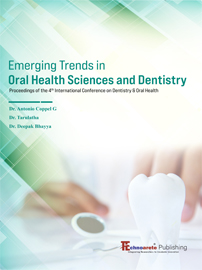


Department of Pedodontics and Preventive Dentistry Chettinad Dental College & Research Institute, Rajiv Gandhi Salai, Kelambakkam, Kancheepuram District, Tamil Nadu – 603 103, India
Corresponding Author: dhanalakshmi7777@yahoo.com
Department of Pedodontics and Preventive Dentistry, Chettinad Dental College & Research Institute, Rajiv Gandhi Salai, Kelambakkam, Kancheepuram District, Tamil Nadu – 603 103, India
Corresponding Author:dayaswathi@gmail.com
Department of Pedodontics and Preventive Dentistry, Chettinad Dental College & Research Institute, Rajiv Gandhi Salai, Kelambakkam, Kancheepuram District, Tamil Nadu – 603 103, India
Corresponding Author: Dr.eaga_ars@yahoo.com
Department of Pedodontics and Preventive Dentistry, Chettinad Dental College & Research Institute, Rajiv Gandhi Salai, Kelambakkam, Kancheepuram District, Tamil Nadu – 603 103, India
The goal of this study is to examine and appraise pit and fissure sealants' marginal sealing efficacy . Fifty healthy premolars were selected which was extracted atraumatically for orthodontic treatment and out of which 25 for Group I ( Conseal F )and 25 for Group II ( Embrace Wet Bond). The pit and fissure sealants were applied to the concerned groups, stored in artificial saliva, thermocycled and placed in 1% methylene blue solution . The teeth were rinsed, divided buccolingually and viewed for microleakage with optical stereomicroscope based on the penetration of dye, using Williams B and Winter GB criteria. At 95% confidence level statistical analysis was performed with Mann -Whitney test and chi square test .On comparing the microleakage scores a statistically significance was found (p< 0.001) .Group I (Conseal F ) showed a better marginal sealing efficiency than Group II (Embrace Wet Bond)
[1] Beltrán-Aguilar ED, Barker LK, Canto MT, Dye BA, Gooch BF, Griffin SO, et al. Surveillance for dental caries, dental sealants, tooth retention, edentulism, and enamel fluorosis--United States, 1988-1994 and 1999-2002. MMWR Surveill Summ 2005;54:1-43.
[2] Germán-Cecilia C, Gallego Reyes SM, Pérez Silva A, Serna Muñoz C, Ortiz-Ruiz AJ. Microleakage of conventional light-cure resin-based fissure sealant and resin-modified glass ionomer sealant after application of a fluoride varnish on demineralized enamel. PLoS One 2018;13:e0208856. https://doi.org/10.1371/journal.pone.0208856.
[3] El Motayam KM, Fouad WA, Youssef R. Assessment and Comparison of Nanoleakage and Resin Tag Length of Three Different Pit and Fissure Sealants: An In-Vitro Scanning Electron Microscope Study. J Am Sci 2013; 9:329-37.
[4] Ganesh M, Shobha T. Comparative evaluation of the marginal sealing ability of Fuji VII and Concise as pit and fissure sealants. J Contemp Dent Pract 2007;8:10-8.
[5] Newbrun E. Preventing dental caries: current and prospective strategies. J Am Dent Assoc 1992;123:68-73.
[6] Brown LJ, Kaste LM, Selwitz RH, Furman LJ. Dental caries and sealant usage in U.S. children, 1988-1991: selected findings from the Third National Health and Nutrition Examination Survey. J Am Dent Assoc 1996;127:335-43.
[7] Ahovuo-Saloranta A, Forss H, Walsh T, Hiiri A, Nordblad A, Mäkelä M, et al. Sealants for preventing dental decay in the permanent teeth. Cochrane Database Syst Rev 2013;3:CD001830. http://dx.doi.org/10.1002/14651858.cd001830.pub4
[8] . Rudolph JJ, Phillips RW, Swartz ML. In vitro assessment of microleakage of pit and fissure sealants. J Prosthet Dent 1974;32:62-5.
[9] Singla A, Garg S, Jindal SK, Suma Sogi HP, Sharma D. In vitro evaluation of marginal leakage using invasive and noninvasive technique of light cure glass ionomer and flowable polyacid modified composite resin used as pit and fissure sealant. Indian J Dent Res 2011;22:205-9.
[10]Prabhakar AR, Murthy SA, Sugandhan S. Comparative evaluation of the length of resin tags, viscosity and microleakage of pit and fissure sealants - an in vitro scanning electron microscope study. Contemp Clin Dent 2011;2:324-30.
[11]International Organization for Standardization. ISO/ TR 11405:1994. Dental Materials – Guidance on Testing of Adhesion to Tooth Structure. Geneva (CH): International Organization for Standardization; 1994. .
[12]Penugonda B, Scherer W, Cooper H, Kokoletsos N, Koifman V. Bonding Ni-Cr alloy to tooth structure with adhesive resin cements. J Esthet Dent 1992;4:26-9.
[13]Styner D, Scherer W, LoPresti J, Penugonda B. Bonding composite to glass ionomer with adhesive resin cements. J Esthet Dent 1992;4:13-5.
[14]Styner D, Scherer W, LoPresti J, Penugonda B. Bonding composite to glass ionomer with adhesive resin cements. J Esthet Dent 1992;4:13-5.
[15]Styner D, Scherer W, LoPresti J, Penugonda B. Bonding composite to glass ionomer with adhesive resin cements. J Esthet Dent 1992;4:13-5.
[16] Panse AM, Nair MC, Patil AS, Bahutule SR. Comparison of microleakage, bond strength, and fracture strength of no etch no bond novel flowable composite as a pit and fissure sealant in comparison to the conventional sealants: an in vitro study. Int J Pedod Rehabil 2018;3:28– 32.
[17] Eliades A, Birpou E, Eliades T, Eliades G. Self-adhesive restoratives as pit and fissure sealants: A comparative laboratory study Dent Mater J 2013;29:752–62
[18] Deshpande A, Sudani U, Bargale S, Poonacha KS, Kadam M, Joshi N. Six months clinical performance of self etch-self adhesive flowable composite and conventional pit-and-fissure sealants in 7 to 10 year old children. J Adv Med Dent Scie Res 2016;4: 38-43.
[19]Ratnaditya A, Kumar MG, Avula SS, Jogendra MZ, Kandregula CR, Chowdhary Kopuri RK. Clinical evaluation of retention in hydrophobic and hydrophilic pit and fissure sealants: a two year follow-up study. J Young Pharm 2015;7:171-9.
[20] Schlueter N, Klimek J, Ganss C. Efficacy of a moisture-tolerant material for fissure sealing: A prospective randomised clinical trial. Clin Oral Investig 2013;17:711-6.
[21]. Hepdeniz OK, Temel UB, Ugurlu M, Koskan O. The effect of surface sealants with different filler content on microleakage of Class V resin composite restorations. Eur J Dent 2016;10:163-9.
[22] Chávez-Lozada J, Urquía-Morales C. In-vitro evaluation of bond strength of four self-etching cements. Acta Odontol. Latinoam 2017;30:101-8